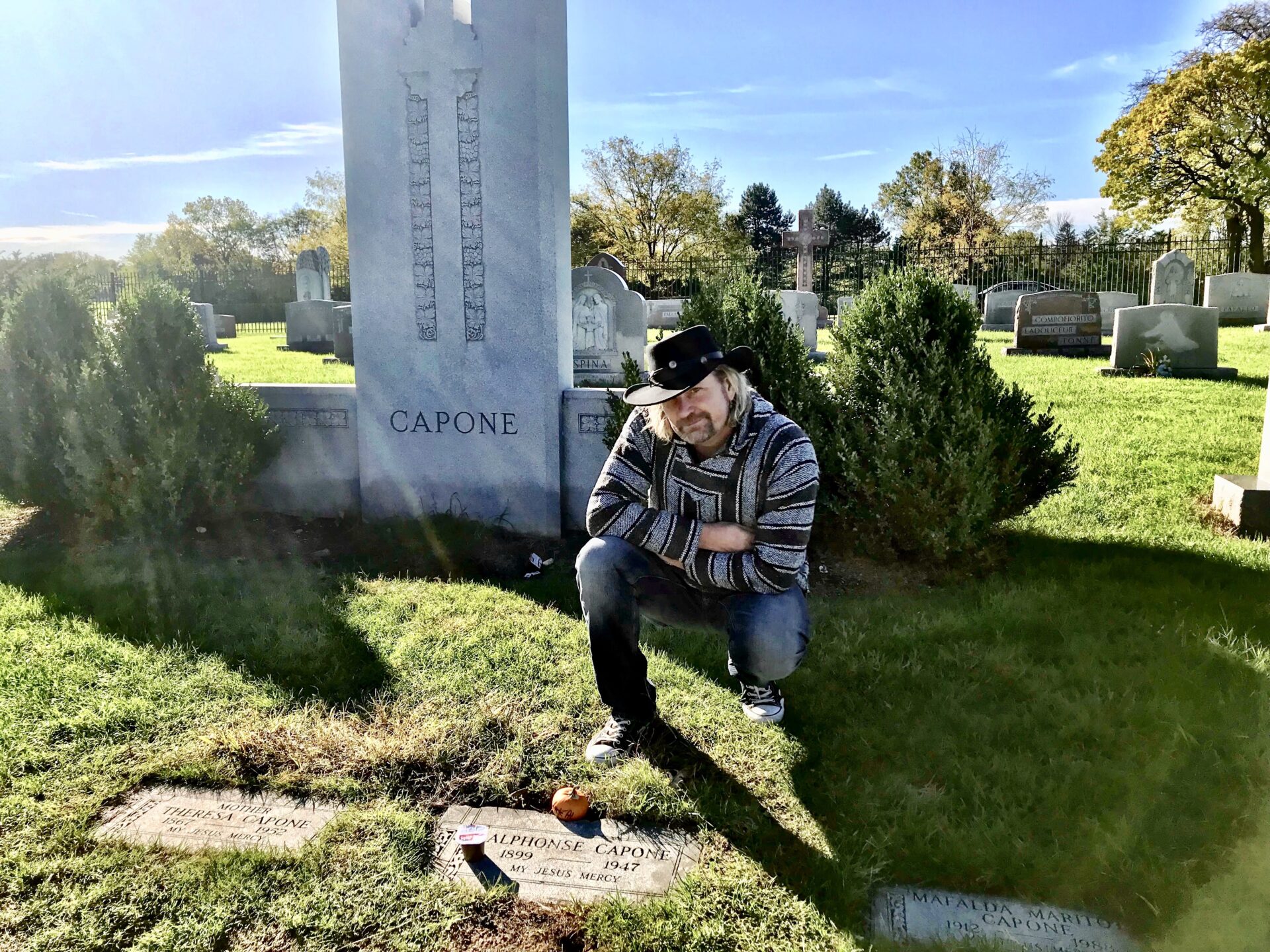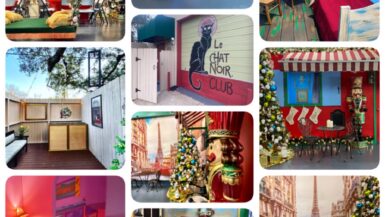I visit cemeteries. Not so much because I have a fascination with them or dead people. I have just found it extremely interesting to visit a city and see if there’s anyone notable buried there that I may have heard of. Then I go visit them: rock stars, movie stars, famous magicians, or even presidents have ended up on my list. I don’t know if I like the scavenger hunt aspect of it or just collecting a list of people I never had a chance to meet in real life. When I decided to spend a few days in Chicago, Al Capone popped up first on every internet search. Al Capone was the consummate bad guy; the man who became public enemy number one. I must confess my only knowledge of the famous gangster was from a few movies I’d seen such as “the Untouchables”. As luck would have it, the cemetery where Alphonse is buried is only 20 minutes from the O’Hare airport.
Capone was working in brothels in New York City before he came to work in Chicago as bodyguard for Johnny Torrio. Johnny got a belly full of lead from a rival gang, but miraculously enough survived. He opted to retire and gave control to Capone. Al expanded the bootlegging business and ran it for seven years before being thrown in prison for tax evasion. Because of his public persona and connections with law enforcement, Capone was “untouchable” until The Valentine’s Day Massacre, which cost him his popularity and put him on the FBI’s naughty list. Although he was never officially connected to the crime, public perception was that he had murdered the rival gang. Capone is long gone, but after stopping by his grave, I became fascinated by his story and started finding other interesting places in the Chicago area. The following is a short list of Al Capone tourist spots for those interested in his legacy.
Al Capone’s Grave–
Google maps includes the final resting places of a surprisingly large number of graves and Capone’s grave was easy to find. Alphonse and his family are buried at Mt. Carmel Cemetery, Proviso Township, Ill. Once you enter the main gate, turn right at the first road and you can’t miss the big monument with “Capone” etched on it. Each family member, including the crime boss, has a small simple stone marking their grave. The family was originally buried at Mt. Olivet cemetery but recurring vandalism warranted moving the bodies to another cemetery. The former grave marker was left at Olivet in hopes that would-be vandals wouldn’t know the new location. I expected something a little more elaborate in a cemetery full of beautiful mausoleums and marbled works of art, but such things are often targets. Capone passed away in his Miami home on January 25,1947 and his body was transported to Chicago where most of his family lived. Ironically enough, Al Capone died from a heart attack brought on by syphilis, not in a machine gun standoff or some other glamorous Hollywood ending. After eight years in jail, his health had deteriorated so badly, he was just a shadow of the infamous camera-loving gangster he used to be. His gravestone is as simple as his ending. The address for the cemetery is 1400 S Wolf Rd, Hillside, IL 60162.
The Green Mill Cocktail Lounge
As America’s answer to Paris’s Moulin Rouge (Red Windmill), Chicago entrepreneur Tom Chamales developed the Green Mill in 1910 from a former roadhouse. During Capone’s time, it became a speakeasy with secret tunnels and the inspiration for the Frank Sinatra movie, Joker is Wild. The club was partially owned by Capone’s associate Machine gun McGurn, and Al Capone was known to frequent the establishment and sit in the first booth right past the bar. In it’s heyday, big name acts like Al Jolson and Billie Holiday performed on it’s stage. Today the bar remains, a bit smaller, but with top jazz acts and original furnishings. You can slide in Al Capone’s booth and drink Chicago’s most bitter libation, Jeppson’s Malort liqueur, and transport yourself back to the roaring 20s. If you’re lucky, someone might show you the entrance to the secret tunnel. The bar is located at 4802 N Broadway St, Chicago, IL 60640.
Capone’s Chicago Home-
Capone’s home at 7244 South Prairie Ave, Chicago was originally built in 1908, and purchased by the mafia boss in 1923. Capone lived there until he bought his Miami home and let his mother, Theresa Capone live there. Theresa remained at the address until her death in 1952, when it was sold to William B. Petty. The house has had a few owners since then, but is not open to the public. You can drive by it and take a picture though. In 2016, it was up for sale for about $179,000. Most of the homes in the neighborhood were built around the same time period.
Capone’s Miami Home–
In 1928 Capone bought a summer retreat home on Miami Beach’s man-made Palm Island. He was instantly unpopular with law enforcement who did their best to keep him out of Miami. In 1931 he was arrested for tax evasion and spent 8 years of incarceration in various prisons including Alcatraz. When he returned home, he was ill with advanced stages of syphilis that would claim his life in 1947. His Miami home eventually fell into disrepair until it was bought by investors, underwent major renovations and now is available to rent for photo and video shoots. It’s been renamed 93 Palm and is not open to the general public. It’s a little difficult to see since it’s on a private island, so you might have to rent a helicopter or drop a name or two to get past security.
Valentine’s Day Massacre Wall-
America’s most famous gangster shooting occurred on February 14, 1929 at a garage on 2122 North Clark Street when seven people associated with the George Moran’s Northside gang were gunned down by a rival gang believed to be Al Capone’s. Two of the four shooters were dressed in police uniforms. Al Capone was in Miami at the time of the shooting, and had a firm alibi, but public opinion quickly turned against him and tolerance for the mobs that had been furnishing the public with bootlegged alcohol shifted. The garage where the crime occurred was torn down in 1967, but a Vancouver businessman bought the bricks, numbered them, and they became part of a touring mob exhibit for almost 42 years. The bricks were reassembled back to their original order and finally found a permanent home in the Mob Museum in downtown Las Vegas. The bullet holes remain and visitors can pose with the infamous wall. There’s nothing left to see on North Clark street, but that doesn’t dissuade the tour groups from a stop there.
In addition to Al Capone, famous gangsters like Bugs Moran, Baby Face Nelson and John Dillinger and many other famous mobsters were based in Chicago. Most officials don’t want to romanticize their city’s history of the gangsters that dominated Chicago during Prohibition, but a few tour companies have put together tours to the most important places still standing. Guides are usually dressed in period clothing and add humor and some acting chops to the history of the city as they drive you from place to place. Untouchable Tours, Chicago Crime Tours, or the Family Secrets Tour, where you are taken on tour by Frank Calabrese, Jr., an actual mobster’s son are three of the city’s most popular tours.





